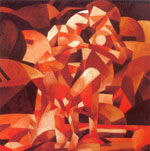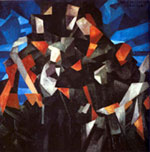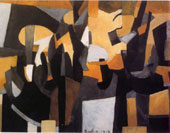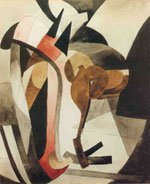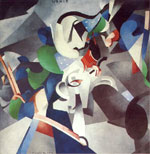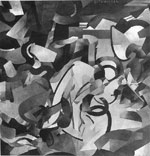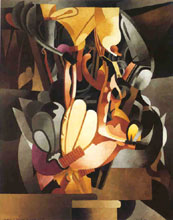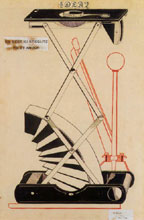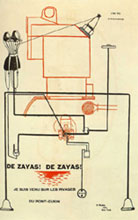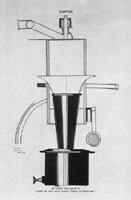Between Music and the Machine: Francis Picabia and the End of Abstraction by
Roger I. Rothman |
|||||||||||||||||||||||||||||||||||||||||||
|
1913-1915
In January 1913, just two months after their trip to the Jura mountains with Guillaume Apollinaire and Marcel Duchamp, Francis Picabia and his wife, Gabrielle Buffet, boarded an ocean-liner for New York. They arrived just three days after the opening of the Armory Show, where Picabia showed Paris, Memory of Grimaldi, Dances at the Spring (Fig. 1), and Procession in Seville (Fig. 2). (1) More clearly cubist in technique and less radically at odds with perceived notions of modern painting than the work that drew the bulk of the critics' ire, Duchamp's Nude Descending a Staircase, Picabia's three paintings nonetheless received considerable attention in the press, some of which was quite positive. (2) Almost immediately upon his arrival in New York, Picabia was introduced to a small group of artists interested in the European avant-garde, including Mabel Dodge, Alfred Stieglitz, Marius de Zayas, and Paul Haviland. In March, Picabia had his first one-man show at Stieglitz's gallery where he presented a collection of freshly completed drawings and watercolors (Fig. 3,4), works he described as abstractions, pure paintings having no longer any relation to perceived reality. As he described his works in a text written expressly for the exhibit: "In my paintings, the public is not to look for a ‘photographic' recollection of a visual impression or sensation, but to look at them as simply an attempt to express the purest part of the abstract reality of form and color in itself." (3)
In April, he and his wife returned to Paris, where he immediately began work on translating these small watercolors into large, ambitious paintings, designed, in all likelihood, as grand salon-pieces, manifesto-works of his commitment to abstraction (a word, claimed Duchamp, "that he invented" (4) ). At the Salon d'Automne, Picabia presented two of these works, Udnie (Fig. 5) and Edtaonisl (Fig. 6), both of which stand about nine feet on each side, with their perplexing titles
In early 1915,
Picabia and his wife returned to New York, where he took up again with
the Stieglitz group, itself experiencing a shift toward a more explicit
embrace of modernity and its technological inventions. Along with de
Zayas, Picabia began work on a new magazine, 291 (named after
the address of Stieglitz's gallery). As part of a celebratory, inaugural
gesture, Picabia prepared a series of mechanical portraits. He represented
Stieglitz as a camera (Fig. 8); Haviland
as an electric lamp; de Zayas as a complex arrangement of a woman's
corset attached to a spark plug which was itself attached to an engine
(Fig. 9); Agnes Meyer (a collector and
close friend of de Zayas) as a spark plug. Picabia represented himself
as a composite horn-cylinder-spark plug (Fig. 10)
(appropriate for a man who was to own some 120 cars during the course
of his life (7)).
In the following months, Picabia transformed these mechanical portraits into larger paintings, referred to by most scholars as "mechanomorphs." Unlike the earlier portraits, these works were more elusive, less concerned with the accurate depiction of real machine parts, than in manipulating the formal properties of various fragments of largely unrecognizable machines. In transforming the modest portraits of 291 into large-scale paintings on board, Picabia was reenacting the process used in his earlier transformation of the small New York watercolors into the enormous abstractions painted upon his return to Paris. >>Next
Notes
|
|||||||||||||||||||||||||||||||||||||||||||
|
|||||||||||||||||||||||||||||||||||||||||||
